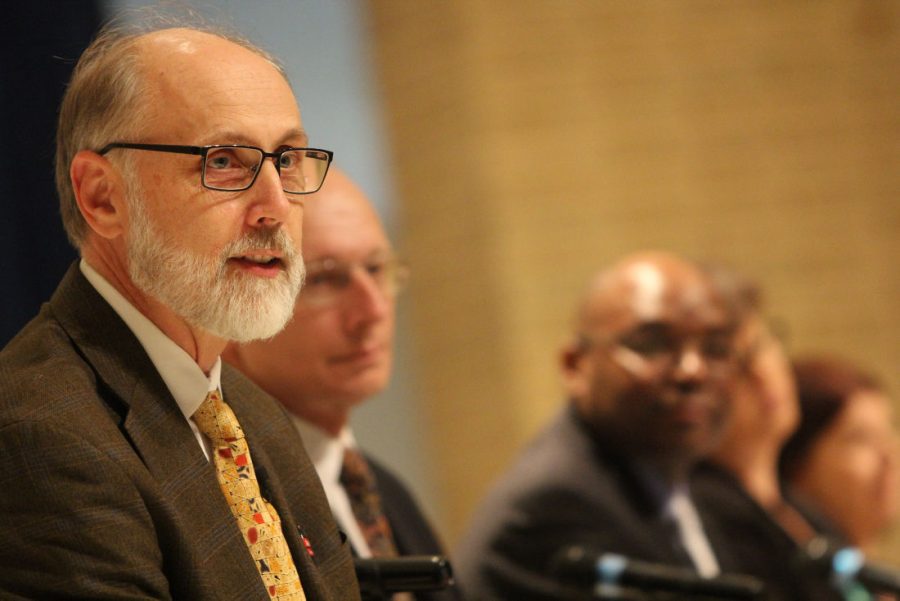NIU leaders talk enrollment, state funding issues
NIU President Doug Baker (left); Allan Phillips, vice president of Administration and Finance; Eric Weldy, vice president of Student Affairs and Enrollment Management; Admissions Director Dani Rollins; and Lisa Freeman, executive vice president and provost, discuss state funding, falling enrollment and program prioritization during a town hall meeting Sept. 2 in the Student Holmes Center, Carl Sandburg Auditorium. Baker said NIU will find alternatives for the State Employees Group Insurance Program who will have to pay out of pocket for medical claims.
September 3, 2015
NIU President Doug Baker and four administrators updated an audience of more than 100 community members, faculty, staff and students on funding cuts, falling enrollment and program prioritization during a town hall meeting Monday.
Among the individuals leading the discussion were Alan Phillips, vice president of Administration and Finance; Eric Weldy, vice president of Student Affairs and Enrollment Management; and Lisa Freeman, executive vice president and provost. Each administrator presented an issue NIU is facing and solutions their divisions are spearheading.
State and NIU budgets
Despite the continued back and forth between Gov. Bruce Rauner and the General Assembly over an appropriate state budget, one that is traditionally decided in late spring, Phillips said NIU will continue to receive the $8 million Illinois owes for fiscal year 2015.
“We will do what we have to do to get through the year,” Phillips said. “Our hope is that there will be some form of agreement in Springfield sooner rather than later.”
The Board of Trustees Finance, Facilities and Operations committee approved a $388 million budget Aug. 27. The proposed budget represents a $36.5 million decrease from last year’s $424.5 million budget.
The Board of Trustees will vote on whether or not to approve the budget Sept. 17, but it may still be subject to change, as state funding cuts may not be as drastic as Rauner’s proposed $29.3 million cut, according to a Budget Update from Baker.
State appropriations for higher education have been reduced by more than $1 billion since 2002, a reduction of about 30 percent, Phillips said.
“During that time, to make up the difference … tuition and fees increased, but that still did not increase enough to make up the difference,” Phillips said. “And now we’re now to a point where we can’t continue to raise fees and tuition because now we’re becoming uncompetative largely with the states that surround Illinois and the private institutions, so we’re holding the line on costs.”
Phillips proposed a $10 million cut to procurement and the creation of a contracting office to streamline the speed at which contracts are created. Another initiative NIU will begin for a sustainable budget is to push budgets out to five years, Phillips said.
Enrollment
Weldy highlighted three main reasons for declines in enrollment, which has fallen from 24,424 in fall 2009 to 20,611 in fall 2014. The number of high school students who graduate and go to college has declined, prospective students are looking at out-of-state colleges to attend instead of NIU, and competition from universities that recruit in the Chicagoland area is the highest it’s ever been, Weldy said.
“One thing that I can tell you that I started doing when I first arrived is I really took a look and evaluated and assessed my staff at enrollment management,” Weldy said. “And … one thing that really attracted me to NIU is that I felt like we had the talent and resources to overcome any obstacle.”
A major change made to enrollment management to increase the number of prospective students was the implementation of a two-day orientation as opposed to one, a change that allowed families to have more time to see the campus and resources, Weldy said.
“Students were able to see themselves at NIU by building a closer connection to our current students, faculty and staff,” Weldy said. “What better way for students and families to see themselves as part of this community than to spend time with members of our community?”
Program Prioritization
Almost 500 academic and administrative programs may be sorted into five categories in an effort to determine funding mergers, cuts and increases, Freeman said. Those five categories are candidate for enhanced resources; continue as is, no change in resources; continue as is, reduction in resources; requires transformation; and candidate for elimination, consider for further review, Freeman said.
“In order for us to stay true to our mission, when we think about our five-year budgets and where we’re gonna put the money, we have to have a mechanism for making sure that we align our resources for the things that really matter, that we actually don’t have just accessible and affordable programs but also high quality programs,” Freeman said.
A $49,000 software will be used by task forces, department heads and community leaders to write narratives and answer questions related to academic and administrative criteria in accordance with each program, according to a July 7 Northern Star article. Programs will be evaluated by task force members starting in January.







